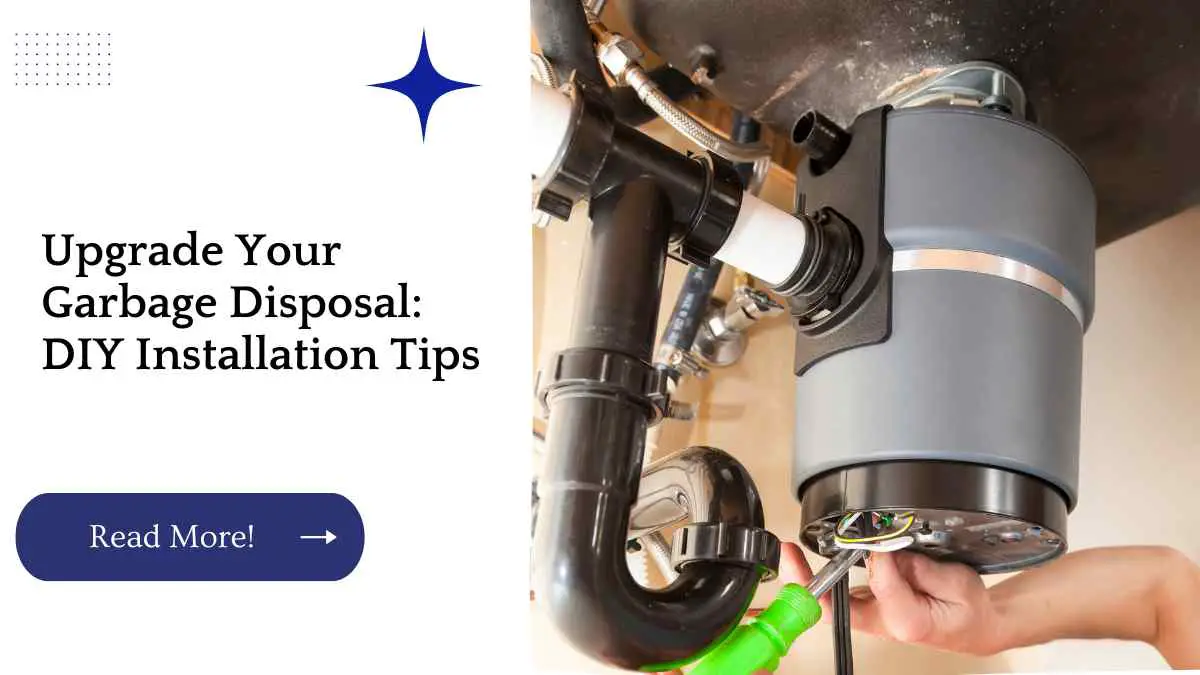A high-quality garbage disposal is an essential appliance in any modern kitchen. Not only does it make clean-up a breeze, but it also helps reduce waste and decrease the risk of clogs and blockages in your pipes. However, if your current garbage disposal is old, slow, or not functioning as well as it should be, it may be time for an upgrade.
In this article, we’ll walk you through the process of installing a new garbage disposal on your own, without the need for a professional plumber. By following these DIY installation tips, you can have a new, efficient, and effective garbage disposal up and running in no time.
| Key Takeaways |
|---|
| Benefits of upgrading your garbage disposal include increased efficiency, reduced noise, and decreased risk of clogs and blockages. |
| Before starting the installation, make sure to gather all necessary tools and materials, shut off power and water, and remove the old disposal. |
| The installation process includes mounting the new disposal, connecting wiring, and attaching drainage pipes. |
| After installation, it’s important to test for leaks and troubleshoot any common problems that may arise. |
| To maintain your new garbage disposal, be sure to clean it regularly and avoid putting certain materials down the drain. |
Benefits of Upgrading Your Garbage Disposal
Upgrading your garbage disposal has several benefits, including:
- Increased Efficiency: A newer, more advanced garbage disposal can grind up food waste more effectively, reducing the risk of clogs and blockages in your pipes.
- Reduced Noise: Older garbage disposals can be noisy and disruptive, while newer models are designed to operate more quietly.
- Decreased Risk of Plumbing Issues: A high-quality garbage disposal can help prevent plumbing issues, such as clogs and blockages, that can be expensive and time-consuming to fix.
Tools and Materials Needed
Before you begin the installation process, make sure you have all of the necessary tools and materials. Here’s what you’ll need:
- Screwdrivers (both Phillips and flathead)
- Adjustable wrench
- Plumber’s putty
- Electrical tape
- Wire connectors
- Garbage disposal installation kit
- New garbage disposal
Looking to illuminate your kitchen with under-cabinet lighting? Check out our DIY guide on installing under-cabinet lighting for an easy and affordable way to brighten up your cooking space.
Preparing for Installation
Before you begin the installation process, there are a few important steps you need to take to prepare:
Shutting Off Power and Water
First, make sure to turn off the power and water supply to your old garbage disposal. You can do this by turning off the circuit breaker that powers the disposal and shutting off the water valve under your sink.
Removing the Old Disposal
Next, you’ll need to remove the old garbage disposal. Start by disconnecting the drainage pipes and wiring from the disposal.
Don’t let a malfunctioning refrigerator ruin your day. Our guide on troubleshooting common refrigerator problems offers simple and effective solutions to keep your fridge running smoothly.
Installing the New Disposal
Now that you’ve removed the old garbage disposal, it’s time to install the new one. Here’s a step-by-step guide to help you through the process:
Mounting the Disposal
- First, attach the mounting assembly to the bottom of the new disposal unit, following the manufacturer’s instructions.
- Then, insert the mounting gasket into the mounting assembly, making sure it’s seated properly.
- Align the mounting tabs on the mounting assembly with the mounting ring, and then twist the disposal until it locks into place.
- Use a screwdriver to tighten the screws on the mounting assembly until they’re snug.
“Black specks in your bathtub can be unsightly and unsettling. Our guide on how to fix black specks in your bathtub offers DIY solutions to banish those pesky spots and keep your bathroom looking clean and fresh.
Connecting the Wiring
- Connect the electrical wiring to the new disposal unit, following the manufacturer’s instructions.
- Use wire connectors to connect the wires, and then wrap them in electrical tape.
- Finally, tuck the wires into the electrical box and secure the cover.
Attaching the Drainage Pipes
- Attach the drainage pipes to the new disposal unit, following the manufacturer’s instructions.
- Apply a small amount of plumber’s putty to the sink flange, and then place the flange onto the sink drain hole.
- Tighten the mounting assembly and flange screws until they’re snug, but be careful not to over-tighten and damage the sink or flange.
- Finally, connect the drainage pipes to the disposal unit, using a wrench to tighten the connectors until they’re snug.
Make laundry day a breeze with the right setup. Our guide to efficient laundry setup: washing machine and sink drainage provides tips and tricks for optimizing your laundry room and avoiding potential plumbing issues.
Testing and Troubleshooting
After you’ve installed the new garbage disposal, it’s important to test it and troubleshoot any problems that may arise. Here are some tips to help you through the process:
Checking for Leaks
- Turn the water supply back on and run water through the disposal unit.
- Check for leaks around the sink flange and drain connections.
- If you notice any leaks, tighten the connectors until the leaks stop.
Troubleshooting Common Problems
- If the disposal unit doesn’t turn on, check the electrical connections and make sure the power supply is turned on.
- If the disposal unit makes a humming noise but doesn’t grind up food waste, it may be jammed. Turn off the power supply and use a wrench to turn the disposal manually, then remove any obstructions.
- If the disposal unit is leaking from the bottom, it may be damaged and need to be replaced.
Maintenance and Care Tips
To keep your new garbage disposal running smoothly, here are some maintenance and care tips to keep in mind:
- Clean the disposal regularly by running water and a small amount of dish soap through it.
- Avoid putting hard materials, such as bones or fruit pits, down the disposal.
- Run cold water through the disposal while it’s in use, to help solidify and grind up food waste more effectively.
Draining your washing machine outside may seem daunting, but it can actually be quite simple. Check out our step-by-step guide on how to drain your washing machine outside to make the process quick and easy.
Further Reading
Here are some additional resources to help you with your garbage disposal installation:
How to Replace a Garbage Disposal: This step-by-step guide from Family Handyman provides detailed instructions and photos to help you replace your garbage disposal.
Installing a Replacement Garbage Disposal: This guide from InSinkErator’s support website offers tips and advice for installing a new garbage disposal, including troubleshooting common problems.
How to Install a Garbage Disposal: This WikiHow article provides a simple, easy-to-follow guide to installing a garbage disposal, including a helpful video tutorial.
FAQs (Frequently Asked Questions)
Is it safe to install a garbage disposal on your own? Yes, with the right tools and instructions, installing a garbage disposal can be a DIY project. However, if you’re not comfortable working with plumbing or electrical systems, it may be best to hire a professional plumber.
How long does it take to install a new garbage disposal? The installation process can vary depending on your level of experience, but generally takes about 1-2 hours.
Can you install a new garbage disposal without removing the old one? No, you’ll need to remove the old garbage disposal before installing the new one.
Do all garbage disposals require electrical wiring? Yes, all garbage disposals require electrical wiring to function. Make sure to follow the manufacturer’s instructions carefully when connecting the wiring.
What type of food waste can I put down a garbage disposal? Soft foods, such as fruits, vegetables, and bread, are generally safe to put down a garbage disposal. However, avoid putting hard materials, such as bones or fruit pits, down the disposal, as they can damage the blades and motor.

Hellen James is the author of the blog and a licensed plumber with over 15 years of experience. She shares her knowledge and experience in plumbing and drainage through insightful and informative articles

